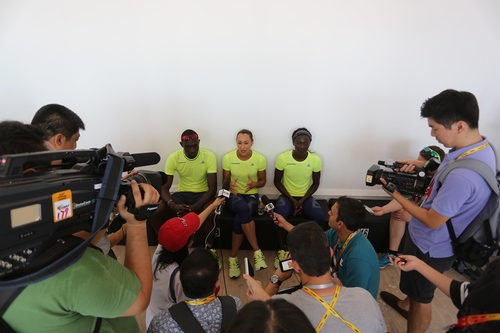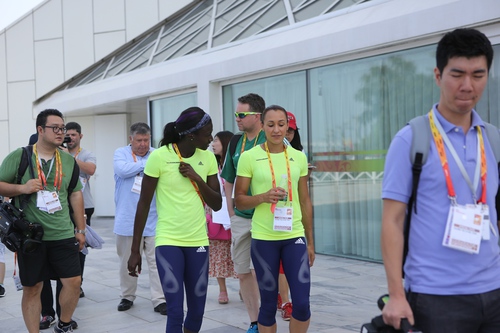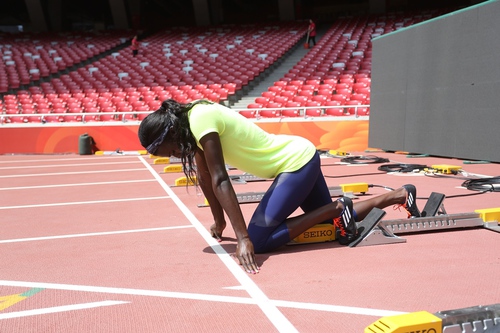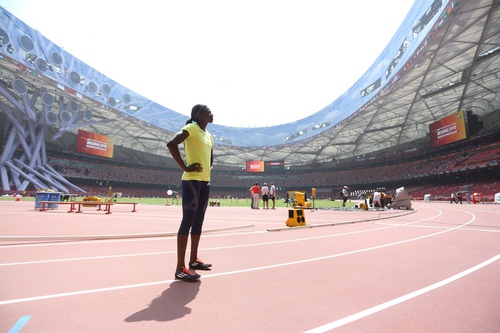 David Rudisha, Jessie Ennis-Hill, Tori Bowie, August 20, 2015, Beijing, photo courtesy of adidas Running
David Rudisha, Jessie Ennis-Hill, Tori Bowie, August 20, 2015, Beijing, photo courtesy of adidas Running
Part of the build up to major events is the press events that various brands provide around Championships and Olympics. As adidas is the global sponsor of IAAF, they put together several events around the World Champs. I was fortunate to interview David Rudisha, Jessie Ennis Hill and Tori Bowie at the adidas presser for ten minutes each (we posted audio from SoundCloud on Runblogrun yesterday). Here is a little bit behind the scenes.
RelatedPosts
There is an art to brands presenting their athletes and product to media. Do they oversell it and loose the interest and credibility? Or, do they find the way to provide content and context to the media while also providing a positive experience with the brand.
 Jessie Ennis Hill, Tori Bowie, assembled media, photo from adidas Running
Jessie Ennis Hill, Tori Bowie, assembled media, photo from adidas Running
In my mind, there have been several great examples over the years of how use access to athlete content and promote the brand. The best EVER was 1995, with Nike at the Goteborg World Champs. While Reebok was sponsor, they did not manage the opportunity well. Nike provided access to athlete interviews each day, with content, product access and interviews done by Steve Miller, then, VP of Sports marketing at Nike. Managed by Keith Peters, the zen master of communications, media came to expect a great performance each day with athletes, some early digital content and the brand stories were woven in, not shoved down our throats. 1996 was pretty good, but the Olympic venues are a challenge.
The content from Nike in 2000 allowed me to provide daily content to our then growing web presence, even with me in US with a busted eardrum. The Sydney content from Nike had stories on each athlete, pictures of uniforms and product info. Again, Nike did it better than anyone else.
In 2004, adidas provided content some time out and access to their iconic athletes. Between them and Reebok’s daily press conferences, and a few pressers with Nike, we had access to most of the brands.
Reebok in 2005 Helsinki and 2007 Osaka were two of the best managed. Access to athletes, in a quiet, easy to find center made a lot of sense. By this time, Nike was doing some fine interview opps, but much less than before and more oriented to the brand and product stories.
In 2008, Nike did some fun opps in Beijing, around unique athletes and product. adidas provided access to some of their iconic athletes and a historical context to the brands’ committment to the Olympic movement. The adidas launch in 2008 in Beijing was one of the best managed I have ever experienced.
Over the years, the Steve Jobs-Mark Parker collaborations over Nike running were pretty spectacular, part of it was Jobs and Parker’s chemistry (Parker once noted he asked Jobs how to make Nike better, and the turlenecked Apple meister noted, ” Stop making crappy shoes.”).
For several years, Nike did spectacular events around Nike running application, Lunar product and the biggest was the 2012 Olympic product launch. Probably 400 media and a well run, focused event, promoting the absolutely complete line Nike had built around Olympic events.
It is a challenge to put all of those pieces together. In the successful times, I have seen, and several have done this with very modest programs. ASICS in 2012 had a nice afternoon access to athletes and a chance to interview their new President, Kevin Wulff. Again, access to their athletes, a brand story, and some access to executives to speak about the brand and sport.
 Tori Bowie, in blocks, adidas media event, August 20, 2015, photo courtesy of adidas Running
Tori Bowie, in blocks, adidas media event, August 20, 2015, photo courtesy of adidas Running
At the World Champs, adidas did three media events, focusing on unique approaches. I went on one where we accompanied Jessie Ennis Hill, David Rudisha and Tori Bowie as they walked us through the Call areas under the stadium and then a chance to see the track and behind the scenes operations of the Beijing Bird’s nest. It was fun and also weaved in the brand story. It was well done.
Interviews with David Rudisha, Tori Bowie and Jessica Ennis-Hill were short, focused and ten minutes each. I enjoyed the access and posted all three.
 Tori Bowie, Beijing Olympic stadium, photo from adidas Running
Tori Bowie, Beijing Olympic stadium, photo from adidas Running
Some times, the most unrehearsed situations are the best. I remember a 2011 event in Daegu, where Trey Hardee had taken gold and Ashton Eaton taken the silver medal. Nike did a quick press event and the communication between Ashton and Trey was amazing. The honesty about their performances was telling and it provided a fine moment. Likewise, in 2007, in Osaka, Carolina Kluft, the magnifiscent heptathlete, did a pressser after her win that was both telling and startling in its honesty. Moments like that come few and far between.
In 2000, David Mingey had a public relations disaster to deal with Marion Jones and CJ Hunter. “Minge” as those who know the guy call him, did not become unglued, but handled it well in public and tried to control what was quickly becoming a disaster. I believe, in retrospect, it may have been, along with Keith Peter’s comprehension of where content and context could support the Nike brand, some of the best moments and support of the Swoosh.
I am reminded of this when I saw Tori Bowie in awe of the Beijing Stadium. I forget sometimes that these young athletes are human too, and besides running, jumping and throwing, they can take the time to see the wonder and beauty in such a stadium and what they do.





















